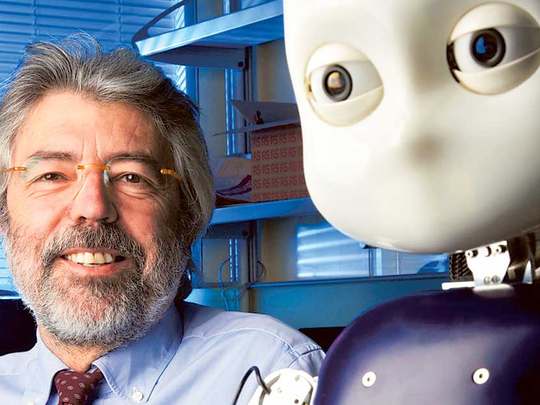
Dubai: Robots designed to mimic people are now on the verge of commercial-scale production, UAE University (UAEU) assistant professor Dr Massimiliano Cappuccio says.
Dr Cappuccio, director of the university’s Interdisciplinary Cognitive Science Laboratory and an organiser of the second Joint UAE Symposium on Social Robotics, said the cost and capabilities of prototype anthropomorphic robots were such that they were almost ready to leave the tech labs and enter the world as luxury items.
“In the last year you can see some serious advances,” he said. “There is the promise of reaching critical mass to start mass production, because you will need at least 100,000, even better one million pieces sold, in order to justify the initial expenses to being mass production.
“At that point you can really invest a lot in research. At the moment, the idea is to sell a hundred, one thousand pieces for special applications, exhibitions. It’s still at a level of luxury — you want to impress an audience.
“When we reach that threshold, then industry will have such an interest that any kind of investment — it doesn’t matter how many zeroes — is justified. At that moment, the technology will spiral.
“It’s a matter of a few years. Already the prices of production are going down, little by little, there are a few thousand units, and it’s just about finding an application in everyday life when people really need that robot and that would justify the scale.”
But the development and use of humanoid robots on such a scale posed moral and ethical questions, said Dr Cappuccio, a philosopher who specialises in cognitive science.
“Do we want robots to be anthropomorphic? How anthropomorphic do we want them to be? There is a debate that we don’t want robots to look like humans for different reasons — one reason is that robots are slaves,” Dr Cappuccio said. “Interacting with robots that act as slaves, there is a moral issue because, even if they don’t have rights, you as a user are putting yourself in a position as if you were exploiting a human agent. The experience is comparable to that of a human exploiting another human, because it looks like a human. That poses ethical questions.”
He said the experience could change the way people react to the exploitation of other people. “It looks very much like a human, and if you behave like a master with a slave, it can definitely be desensitising.”
He added: “It’s one thing to read this in a comic book or a novel; it’s another thing to interact with an agent that looks like a human. It can have psychological long-term effects.”
Cute robots designed to create emotional bonds could also be used to exploit people, he said.
The four-day conference, a joint venture between UAEU and the New York University Abu Dhabi, will take place at UAEU’s campus in Al Ain.
Topics to be covered include the use of robots in medical care, including their use to help autistic people socialise better, the industrial applications and production of robots, self-driving cars, and the advantages and hazards of using anthropomorphic — human-like — robots.
Speakers at the four-day conference include Hyundai Motor Company’s robotics analyst Robert Cheek, Guilio Sandini, Director of Research and Professor in Bioengineering at Italian Institute of Technology, Genoa; and Jun Tani, Director of Cognitive Neuro-Robotics Laboratory & Professor of Electrical Engineering at Korean Advanced Institute of Science and Technology.










